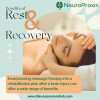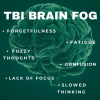How does occupational therapy help brain injury rehabilitation?
Armando did not know who he was or where he was after the car accident. He had fallen asleep at the wheel and was in a coma for 2 weeks, unable to open his eyes or respond to any stimuli. Every lobe of his brain was damaged from the accident.
When Armando found himself at Rancho Los Amigos National Rehabilitation Center, he didn’t know his own family and was extremely confused.
Armando was the manager of a very busy restaurant in Beverly Hills and had family, customers, and coworkers visiting him every day. He was an integral part of the community and needed to get back.
According to Dr. Shawn Phipps “The brain works in mysterious ways but even more mysterious when it’s damaged.”
How do you help someone who doesn’t even know why they are in the hospital? The brain controls everything. It controls how we move, communicate, feel, and think. It affects every aspect of our daily lives.
OT Improves Quality of Life
The goal of occupational therapy is to make the patient independent. Its principles of it are intuitive and have been integrated into medical treatment for centuries.
Occupational therapy focuses on functional skills development that improves social participation, community integration, and emotional well-being. The overall goal of OT is to improve the quality of life for the patient.
It wasn’t that long ago when patients suffering from brain injuries were considered mentally ill and a threat to society. Before the 1800s, they were typically shuttered away in insane asylums and prisons.
Around 1918, Dr. William Dunton noticed that his patients greatly benefitted from busy productive activities. He wrote that “all patients should have occupations which they enjoy. Sick minds, sick bodies, and sick souls may be healed through occupation, and it’s is as necessary as food and drink.
Dunton went on to form the American Occupational Therapy Association and author 2 textbooks on the subject. His writings analyzed therapy in terms of activities creativity, physical effort, social potential, and intellectual demands. He would then match the activities to the needs of the patient. In 1923 he proposed that toy and quilt-making were indeed ideal therapeutic occupations, and in his twilight years became an avid quilter himself.
Dunton’s underlying principles of OT are intuitive and have been integrated into modern medical treatments for years. Functional skills improve the quality of life
An occupational therapist will work with the client to identify the areas of difficulty and comprise a treatment plan that incorporates the daily routine. Realistic settings help set achievable goals and the highest level of independence possible. An occupational therapist can help with the following after a brain injury:
Memory strategies
Fatigue Management
Routine plans
Community access support
Return to work
Career training
Return to sports and social activities
Sleep Quality
Hygiene
Anger management
Behavioral coping strategies
Equipment Specialist
Home adaptations
Family Education
Daily independence activities
Armando finally got to the point where he needed to re-integrate into the community. Dr. Phipps utilized CAPE to help get Armando back to work running a busy Beverly Hills restaurant. Cape is an occupational therapy plan that consists of a challenge, action, practice, and evaluation.
The challenge was to serve the hospital staff, his family, and visitors a meal inside the hospital cafeteria.
They started slowly by walking down the street to the grocery store, just navigating the environment at first. Then they moved on to food preparation and then finally served dinner to eager family members and staff. The challenge was to simulate the busy restaurant atmosphere that Armando would soon be returning to.
Armando was successful with his challenge although he did complain about not getting any tips. But because the occupational therapy copied real life, it helped him gain confidence and life skills to become independent again. Armando recovered and finally went back to managing that busy restaurant.
Occupational therapy challenges the brain with daily life activities to live a better quality of life.



